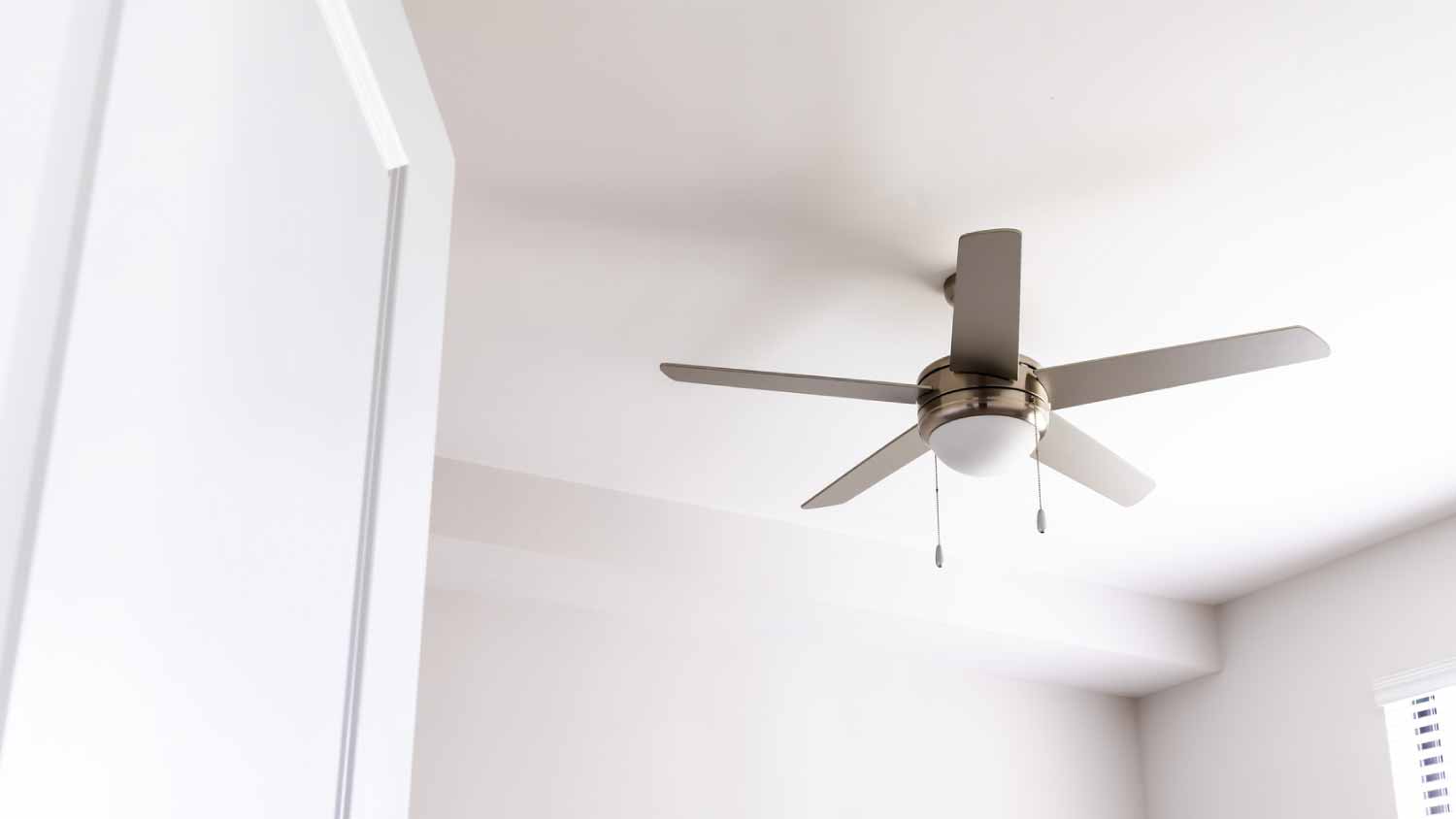What Is a Ventless Portable Air Conditioner and How Does It Work?
When it comes to battling the summer heat, a ventless portable air conditioner is the unsung hero in hot, dry climates


Ventless portable air conditioners evaporate water to cool the air.
They’re easy to install and low maintenance—especially compared to traditional units.
A ventless AC unit costs $110 to $420 on average.
These units work best in warm and dry climates.
Don’t let the name fool you: A ventless portable air conditioner isn’t actually an air conditioner. But when you’re enjoying the cool, refreshing air that these little machines provide, you probably won’t care much about what they’re called. All you’ll be thinking is, “Can I get one for every room?!”
Keep reading to understand these systems' main benefits and drawbacks to find out if they're right for your home.
What Is a Ventless Portable AC?
A ventless portable air conditioner is a system that evaporates water to cool the air. These systems require only water and access to power to work.
The name includes the term “air conditioner,” ventless portable air conditioners are not in fact air conditioners—at least not in the traditional sense. Standard ACs pull hot air into the system to cool, filter, and dehumidify it before recirculating it back into the room. But ventless ACs don’t have a unit that connects outside the home to pull heat in, so they don’t function as a traditional air conditioner unit.
To avoid confusion, many experts refer to them by other names such as:
Evaporative coolers
Portable air conditioners
Whatever you choose to call them, the fact is ventless portable ACs are affordable, energy-efficient, and keep your space cool if the climate is right.
How Do Ventless Air Conditioners Work?
Have you ever noticed how much cooler it feels sitting beside a body of water in the summer? This is because water draws and retains more heat than pretty much any other substance on Earth.
Ventless air conditioners model the same principle. The unit contains its own little pond (usually between 14 and 42 pints of water) that evaporates tiny water droplets into the room, which cool the air after transforming into a gaseous state.
Here’s how ventless ACs operate:
An open tank at the bottom of the unit holds the water reservoir. This gives it a low center of gravity, which helps prevent tipping.
A fan and pump draw water from the reservoir onto a cooling pad, pulling room air across the pad to load it with moisture.
The moistened air is cooler and feels more refreshing than the dry, hot air in your room.
In fact, an evaporative cooler can quickly lower the room temperature by as much as 30 degrees.
Swamp coolers continue running this cycle until the humidity level is too high to evaporate water. Because of this, they’re best for dry climates.
Pros of a Ventless AC Unit
There are a few great reasons to consider adding a unit like this to your home, like that they’re easier to install than central air or ductless units, or that their portability makes them ideal for rental situations.
Ease of Portability
Truly ventless and portable, you can place these units anywhere with access to an electrical outlet.
Easy Installation
Simply plug in, add water and go—with one caveat. Only plug the machine directly into your outlet, as extension cords can cause a short, throw a breaker, or overheat and become a fire hazard.
Affordable
A ventless AC unit is more affordable than other options, usually priced between $110 to $420. Window units cost $170 to $980, depending on the size of the system and its capacity. A traditional HVAC system will run you between $5,000 and $12,500.
Low Maintenance
Evaporative coolers don’t require installation or annual air conditioner maintenance, meaning you won’t need to call or pay a professional. Plus, unlike window units or traditional HVAC systems, you eliminate any need to troubleshoot or repair the system. Other fixes, like changing the air filter, are easy to do independently with such systems.
More Sustainable
Ventless systems are a sustainable solution compared to other options. Evaporative coolers emit no harmful gasses, use no refrigerant, and leave a smaller carbon footprint than a central HVAC unit.
Energy Efficient
If keeping your home cool, your energy costs low, and your carbon footprint even lower is a priority, go with an evaporative cooler. Most ventless portable air conditioners that run continually consume between 90 and 160 watts per hour. By comparison, window units consume around 500 watts per hour, and central air conditioning systems suck up around 3,500 watts per hour.
In fact, you can run a ventless unit 24 hours a day for a fraction of the cost of running a central air conditioner.
Cons of a Ventless AC Unit
Although ventless AC units have a lot of good things going for them, they also come with a couple of downsides. From taking longer to cool down a space to making a home more humid than it already is, here are all the reasons you may want to avoid a system like this.
Not for Humid Climates
Evaporative coolers don’t function similarly in every climate. If you live in a humid environment, swamp coolers probably won’t work for you (despite the “swamp” title implying otherwise). Simply put, the air is already wet and can’t absorb much more water. They’re best for dryer areas where the air's moisture is low.
Lower Output
While efficient, ventless AC systems don’t have as much AC tonnage as other systems. They’re best for cooling one room or a small space—not an entire home.
Slow to Cool
If not running continuously, ventless AC units can take quite a while to cool a space. You’ll want to ensure you keep the water tanks full to work properly all day long.
Cost of Ventless Air Conditioners
Ventless air conditioners range in price from $100 to $1,000 depending on their size, style, and output capacity. For example, you’ll pay slightly more for window units than you will for smaller, portable options.
DIY vs. Hiring a Pro
Because there’s little to no installation required to set up a ventless air conditioner, hiring an HVAC pro near you isn’t necessary in most cases.
However, if you’re implementing a window unit and you live high up or aren’t comfortable lifting something so heavy on your own, a pro can do it without breaking a sweat—or your back.
Should I Get a Ventless Air Conditioner?
Ventless portable air conditioners are best for:
Warm and dry climates: If you live in a warm, dry climate, then you should consider giving an evaporative cooler a try.
Single-room use: Most models will only cool a single room, and you’ll want to make sure to keep your doors and windows closed for optimal cooling.
Budget-conscious homeowners: The affordability and ease of use mean you may be able to afford to install an evaporative cooler in almost every room for less than a traditional system.
Terri Beth Miller contributed to this article.
Frequently Asked Questions
Yes, but they don’t feel the same as an AC-cooled room. You’ll feel cool, moist air, opposite from an HVAC system that dries the air as it cools. Ventless units also have less tonnage than alternatives like ductless and central air, which means they aren’t as capable of quickly cooling large spaces or circulating cold air.
If you’re looking for a portable, budget-friendly cooling solution that doesn’t require any venting or installation, a ventless AC system is a good option. Similarly, this is a great choice if you’re renting an apartment or home and aren’t allowed to make large, structural changes like installing comprehensive HVAC, or you’re in a shared space and only need to cool your own room.
Unlike other types of air conditioning, portable units don’t require venting or any other associated parts like hoses. For that reason, they don’t function the same as their counterparts, but will do a similarly good job of cooling down small spaces and won’t require any installation or much maintenance.
No. With a ventless portable AC system, you don’t need to vent anything out the window—but it will be harder to circulate the hot air from the room without one, so you’ll need to come up with another solution, like placing a fan near a warm spot and facing it towards and open water to push the hot air out.





- Furnace Repair
- Air Conditioning Repair
- HVAC Repairs
- Furnace Installation
- Wood & Pellet Stove Repair
- Dehumidifier & Humidifier Repair
- Heat Pump Companies
- Swamp Cooler Repair
- Wood Stove Services
- HVAC Companies
- Commercial A/C Repair
- Geothermal Installation
- Air Conditioning Installation
- Boiler Repair
- 24 Hour Furnace Repair
- Geothermal Repair
- Heat Pump Repair
- Humidifier Installation
- Thermostat Repair
- Thermostat Installation
- Nest Installation
- Heating & Cooling
- Heating Repair
- Furnace Cleaning
- Furnace Tune-Up
- HVAC Technicians
- Subcontractors
- Furnace Maintenance
- Plumbing & Heating Companies
- Wood Stove Inspection
- Mini Split Installation
- Wall Heater Repair
- Duct Installers
- Pros and Cons of Ventless Gas Fireplaces in the Home
- Everything You Need to Know About Water in Portable Air Conditioners
- 9 Types of Air Conditioners: Pros, Cons, and How to Choose
- What is a Ventless Dryer? And How Does It Work?
- Are Portable Air Conditioners Worth the Money?
- Vented vs. Ventless Dryers: Pros, Cons, and Costs
- What Is Evaporative Cooling? Here’s What to Know
- How Long Does It Take to Replace an AC Unit? 5 Factors That Impact the Timeline
- What’s the Difference Between a Portable AC and a Window AC Unit?
- Does a Gas Fireplace Need a Chimney?










